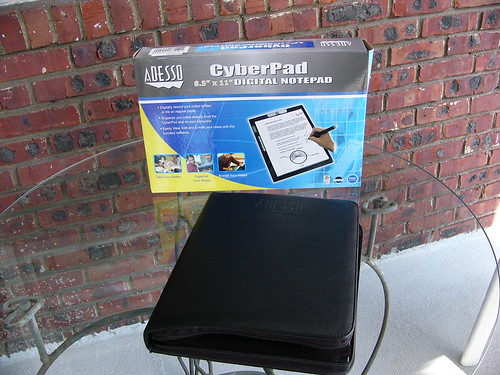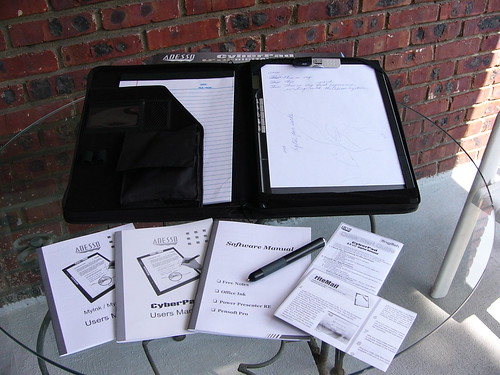 After starting graduate school in the summer, I was captivated by the idea that I could take notes that OCR software would turn into a text file. I began a study of various pens and tablets for note taking. Most of the pens require special paper, so I rejected that idea. A few of the pens I looked into seemed to be vaporware.
After starting graduate school in the summer, I was captivated by the idea that I could take notes that OCR software would turn into a text file. I began a study of various pens and tablets for note taking. Most of the pens require special paper, so I rejected that idea. A few of the pens I looked into seemed to be vaporware.Finally, I was in J&R Computers where I saw an Adesso CyberPad. I spoke at length with the J&R representative. He had no experience with the CyberPad and he did not know anyone who had tried it. He assured me that they sell the pads and that people did not seem to be returning them. I was hesitant to try it after my study of note-taking systems on the Internet, but because of their return policy, I purchased it.
Specifically, reviews of the CyberPad said that it really did give good results, meaning a jpg file of the handwriting. Most reviewers of this product (late August and early September) did not seem to have tried and certainly did not comment on converting the handwriting to text. One reviewer specifically said he had not tried converting the handwriting to text. He did try the email program to email the notes and said it worked very well.
 One nice feature of the CyberPad is that I could use a regular notebook clipped onto the pad to take my notes in regular ink. The mechanism for recording the digital image was picked up from the relative position of the pen on the pad and a quarter-inch to 3/8ths inch of paper stacked on top of the CyberPad clipboard did not matter. In fact, the unit comes with an inexpensive letter-sized legal pad (see in photo; clicking photo reveals a larger image). The pen itself looked cheap with some sort of plastic gripper glued onto the barrel of the pen, but it worked and was not too thick or heavy to hold. It seemed to be balanced fairly well for writing comfortably. The ball point pen made nice, smooth lines on the paper.
One nice feature of the CyberPad is that I could use a regular notebook clipped onto the pad to take my notes in regular ink. The mechanism for recording the digital image was picked up from the relative position of the pen on the pad and a quarter-inch to 3/8ths inch of paper stacked on top of the CyberPad clipboard did not matter. In fact, the unit comes with an inexpensive letter-sized legal pad (see in photo; clicking photo reveals a larger image). The pen itself looked cheap with some sort of plastic gripper glued onto the barrel of the pen, but it worked and was not too thick or heavy to hold. It seemed to be balanced fairly well for writing comfortably. The ball point pen made nice, smooth lines on the paper.Also, it is important for my uses (note taking in college classes) that the CyberPad does not have to be connected to the computer while you are taking notes. It comes with rechargeable batteries and its own battery charger (see third photo). It also has an SD slot to add extra capacity for storing pages to the 32 MB that the pad comes with. It has ample storage space with 26 directories (one for each letter of the alphabet) that can hold 99 files, one file for each page of text that you write adding up to a capacity of 2,574 pages.
I found that the CyberPad did indeed make good jpg files of my handwritten notes. It would be easy to send a copy of such notes to classmates when they missed class. On the other hand, I could easily just scan my regular pencil and pen notes.
The OCR software is where I found deficiency. My package included MyInk software for the conversion. The software did not have a clear manual and the directions for use were obscure. You can see the various manuals from the photo (click on the photo for a larger image that you can read) for six different software titles: MyInk, riteMail, EverNote 1.0, Free Notes, Office Ink, PowerPresenter RE, and Pensoft Pro. [Note: I have revisited reviews of this product in December and found that less software is bundled with the product. J&R is now bundling Adobe Photoshop Elements 5.0 with the product.]
 Other reviewers say that the conversion to text is made by riteMail. riteMail is the program that one uses to view the pages of notes on the computer. I saw nothing about it having OCR capacity, and I tried all the options that were available. But please notice in other reviews that they just say that this is very powerful software that recognizes four languages without giving any specifics as to how it works. Also, notice that the same pictures are in most every review of CyperPad. I think that if word was out that this software worked in translating handwriting to text, it would be big news! Apparently, riteMail is a product of EverNote as they have other "rite technology." [However, riteMail is not listed one their web site in December.]
Other reviewers say that the conversion to text is made by riteMail. riteMail is the program that one uses to view the pages of notes on the computer. I saw nothing about it having OCR capacity, and I tried all the options that were available. But please notice in other reviews that they just say that this is very powerful software that recognizes four languages without giving any specifics as to how it works. Also, notice that the same pictures are in most every review of CyperPad. I think that if word was out that this software worked in translating handwriting to text, it would be big news! Apparently, riteMail is a product of EverNote as they have other "rite technology." [However, riteMail is not listed one their web site in December.]The review that I am the most surprised about is at About.com. I believe that Catherine Roseberry actually used a CyperPad to write and look at the files on her computer, but I do not believe that it translated the jpg files to text. She gives no detail about the translation from handwriting to text. That is the key question in any review and experience with converting handwriting to text. All the reviews just fade away from specifics and barely mention that they got text files from the jpg. If it worked, it would be exceptional given the present state of handwriting recognition. Why would I get hooked into thinking it could be done? Because I use the Palm operating system with my Kyocera phone and daily it converts my handwriting into text.
There was an implication in some of the reviews that I read in late August and early September that this product would work very well with Vista's ink program. The program supplied in the package, MyInk, did some weird things on my computer. After spending more time than I would have liked, I never got one character translated to text. I did see a screen that supposedly worked at the letter-by-letter level. Since removing the software from my computer, I have been getting a message that one of the programs related to my mouse is not loading. I am politely asked if I want to send Microsoft a report about the problem. Restarting the computer fixes it and ignoring the error seems to work as well. [Note: there is no mention of MyInk software in reviews of this product in December.]
Adesso includes EverNote software, which is really a database for managing information. Here one can store and retrieve the jpg images that are created for each page. The addition of key words allows you to find the jpg image with the data. EverNote can store files other than jpg files. I remember hearing about EverNote years ago when it first came out. I was surprised to encounter it again, especially in version 1.0. One would think that it would have made some advances in the couple of years it has been around. In fact, the EverNote web site has version 2.2 which does say it has the capacity to translate handwriting into text. How is it that Adesso can produce an over-priced item and not include the latest versions of the software?
Honestly, I only looked at the Adesso reviews, not the EverNote reviews. I do not understand why a company would not bundle the best software possible with their product. I must admit, that after reading the EverNote reviews, I probably should have upgraded the software and I would have been happy with the Adesso product. With the pressure of working within a short time to try out the product before the opportunity to return it passed, I packed it up and returned it rather than risking spending a lot of money on something that did not work. You can tell by looking at the photo of the documentation, that the manuals were not the original manuals of the various software products. When the customer sees the cheap way they put the pen together plus the cheap production of the manuals, it does not lead to confidence that the product will work. They should take a lesson from Steve Jobs on the importance of design, construction, and packaging of a product. One can download the manual from EverNote and find that it is of better quality. In hindsight, I wish I had checked reviews of EverNote. I did not think that EverNote or riteMail was the software for converting the handwriting to text. I understand now that EverNote 2.2 might be a really good product.
The bottom line: I returned the CyberPad. [Note: This entry was reviewed and edited in December.]

No comments:
Post a Comment